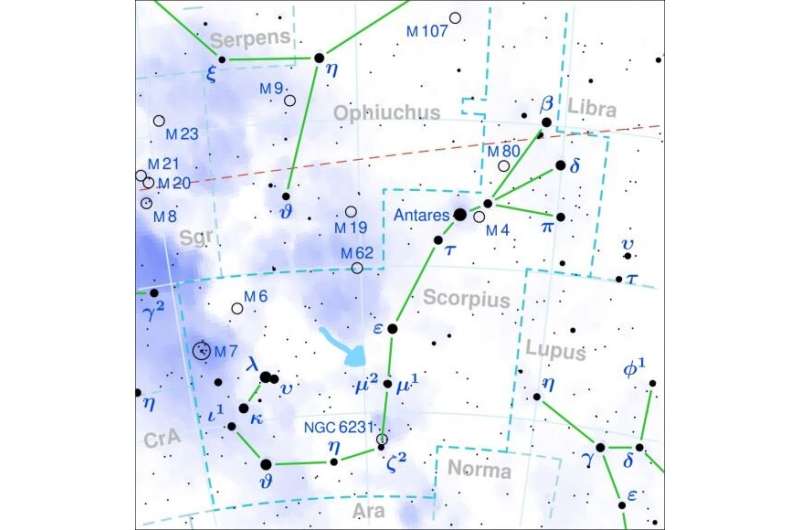
Ninety percent of all exoplanets discovered to date (there are now more than 5,000 of them) orbit around stars the same size or smaller than our sun. Giant stars seem to lack planetary companions, and this fact has serious implications for how we understand solar system formation. But is the dearth of planets around large stars a true reflection of nature, or is there some bias inherent in how we look for exoplanets that is causing us to miss them? The recent discovery of two gas giants orbiting a giant star called µ2 Scorpii suggests it might be the latter.
µ2 Scorpii is a naked-eye star—you can go out and look for it yourself—it forms part of the tail end of the Scorpius constellation, not far below the bright star known as Antares. µ2 Scorpii is a B-type star, nine times the sun's mass—large enough that someday it will explode in a spectacular supernova, before collapsing into a dense neutron star.
Recently, astronomers have been studying µ2 Scorpii as part of the B-Star Exoplanet Abundance STudy (BEAST), and have revealed two gas giants—one still to be confirmed—in orbit around the star. This is the first system of its kind known to us.
Finding these planets wasn't easy. There are several methods used to detect exoplanets. The transit method allows us to catch planets as they pass in front of their star, causing a momentary dip in the star's brightness from Earth's perspective. This method is best at finding planets very close to their star (if a planet takes 12 years to orbit its star—like Jupiter does—it would take 12 years to see the light dip again. Its much easier to find stars with orbits measured in days or weeks).
The radial velocity method, meanwhile, catches planets by watching a star wobble as planets tug at it gravitationally, slightly red- or blue-shifting the star's light spectrum. But radial velocity is also biased toward finding planets very close to their host star.
Large stars with distant gas giants planets would be easily missed by both the radial velocity and transit methods.
Luckily, in certain situations, direct detection of planets is possible. For this to work, the planet has to be far enough from it's star that it won't be drowned out by the overwhelming light of the star. The planet also has to be massive enough to be seen, and it has to be young enough to be bright (young planets glow hot). Finally, the whole star system has to be close enough to Earth for our instruments to pick them up. This is how BEAST was able to discover the two planets orbiting µ2 Scorpii, which is part of a star cluster not too far away.
What are the implications of this discovery? Well, it's early evidence that this type of planet is not as rare as exoplanet data has suggested to date. If BEAST continues to find more gas giants like those around µ2 Scorpii, we will have to rethink what we consider to be the most "common" planetary bodies in the galaxy.
Furthermore, our current models of planetary formation don't easily explain the formation of the type of planet orbiting µ2 Scorpii. The Core Accretion model of planet formation, in which dust is slowly collected into a planetary core over millions of years, shouldn't be possible around massive stars, where protoplanetary disks are dispersed more rapidly. In another model, known as Gravitational Instability (GI), the protoplanetary disk is massive enough to become unstable under its own weight, collapsing into giant planets. This can occur much faster than core accretion, and can explain planets around massive stars, but µ2 Scorpii's companion planets are, as the researchers suggest, "not expected according to the mass distribution of objects generated by current GI models." These planets don't fit the models, so the models may need to be updated.
To put the significance of this discovery succinctly, it is clear that the variety of exoplanets that exist are greater than those we are currently able to detect. Systems like µ2 Scorpii hint at this diversity, and will force us to rewrite our models of planetary formation. With each new exoplanet added to our databases, we're learning more and more about the complexity of solar systems in our galaxy, and improving our understanding of the mechanisms at work when planets are born.
Explore further
Citation: Even stars doomed to die as supernovae can have planets (2022, May 9) retrieved 9 May 2022 from https://phys.org/news/2022-05-stars-doomed-die-supernovae-planets.html
This document is subject to copyright. Apart from any fair dealing for the purpose of private study or research, no part may be reproduced without the written permission. The content is provided for information purposes only.
https://phys.org/news/2022-05-stars-doomed-die-supernovae-planets.html
2022-05-09 13:45:22Z
CAIiEILTqiUIxJNkwWR21dmGQvsqGAgEKg8IACoHCAowpbDpAzCm_hww3-XGBg
Bagikan Berita Ini















0 Response to "Even stars doomed to die as supernovae can have planets - Phys.org"
Post a Comment